Popular kitchen countertops include granite, known for durability and unique patterns; quartz, a low-maintenance, versatile engineered stone; marble, offering luxury and elegance; and butcher block, providing a warm, natural look; while laminate is a budget-friendly and versatile option. Design ideas include choosing stone-effect surfaces for depth and texture, or using a waterfall edge for a streamlined, modern look. Home renovation services by Quality House LLC are designed to transform your space into the dream house you’ve always envisioned.
Discover the Versatility of Kitchen Countertops: Timeless Designs for Every Style
Moving from rudimentary stone slabs for food prep to highly engineered surfaces like granite, which offer unique aesthetics, the kitchen countertops story has evolved from ancient practicality into a centerpiece of kitchen design and function. The design narrative is shaped by trends such as dramatic veining, integrated backsplashes, mixed materials, and textured finishes, all contributing to a unique and personalized kitchen space.
| Did you know?Bold, high-contrast veining is defining upscale kitchens in 2025, transforming countertops into statement pieces. Instead of uniform patterns, designers blend bold, dramatic veining with subtler patterns around the perimeter countertop, creating visual interest. |
Below is the list of countertop materials and design ideas to elevate your culinary space.
- Granite
A classic choice for busy kitchens, granite is durable and offers a unique, natural pattern that adds value to your kitchen. It is available in a wide range of hues, is heat and scratch-resistant, and can suit any decor style. Thicker and high-quality granite countertops cost more but are low maintenance and increase your home’s value.
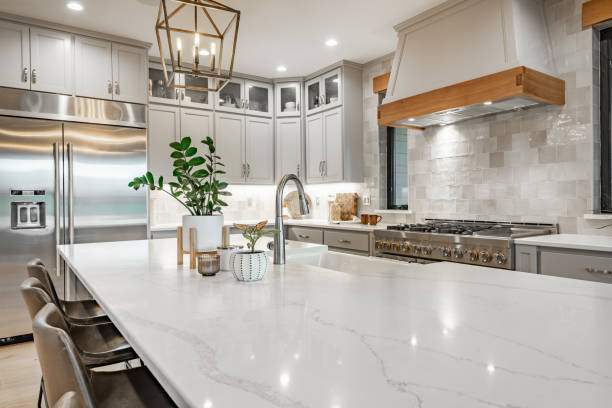
- Marble
For a touch of luxury and timeless elegance, marble countertops are a popular choice, though requiring a little more maintenance than granite. It is more prone to etching, scratches, and stains, but is cooler to the touch, making it ideal for baking. New sealants are making it easier for chefs to go for these countertops without worry.
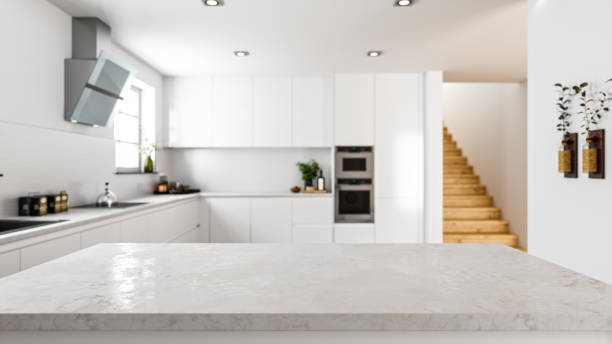
- Quartz
An engineered material, quartz is very durable, available in many styles, and requires low maintenance. It is non-porous, incredibly hard, and never needs to be re-sealed. Quartz countertops are a great way to achieve the look of natural stones without worrying about durability.
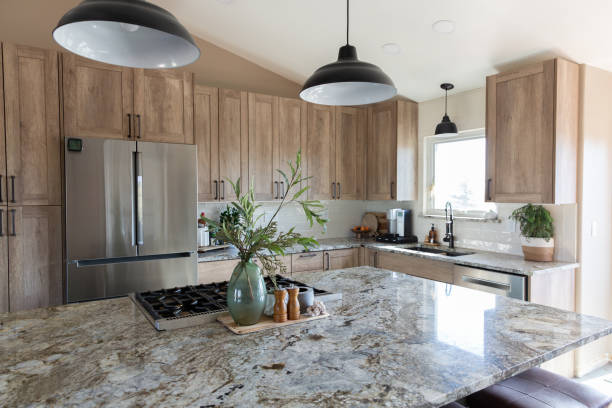
| Interesting factAmong the sustainable options, recycled glass countertop takes the center stage, featuring vibrant, jewel-like fragments suspended in resin or cement, creating unique, colorful surfaces that reduce landfill waste. |
- Butcher Block
If you live a warm, natural aesthetic and do a lot of cooking, butcher block countertops are a perfect fit, blending well with both modern and classic kitchen styles. It’s an affordable alternative to stone countertops and can be sealed or unsealed. Traditionally made from cherry, oak, walnut, or maple, these countertops are porous and must be oiled twice a year.
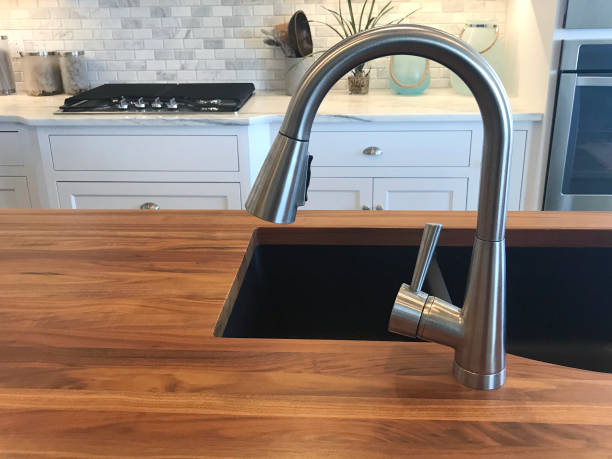
- Stainless Steel
A sleek and hygienic choice, stainless steel countertops are perfect for a modern or professional-style cooking environment. These are easy to maintain and clean, but they can dent and scratch, show fingerprints, and water spots, hence, not ideal for a home with young children.
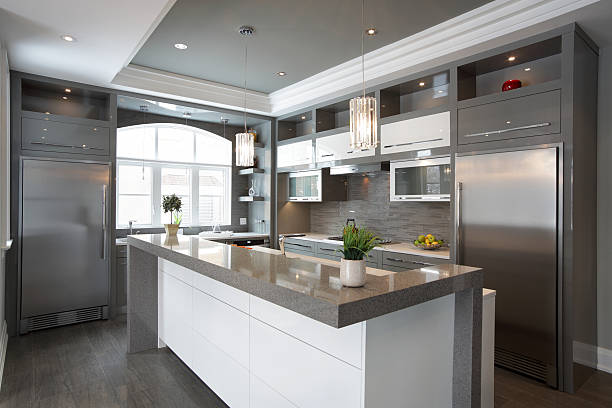
- Polished Concrete
For a trendy, industrial vibe, concrete countertops offer a sleek, contemporary look and can be a cost-effective choice for DIY projects. These are low-maintenance but are notorious for showing scratches and stains. Concrete requires resealing every 3 to 5 years and takes nearly a month to fully seal and become ready to use.
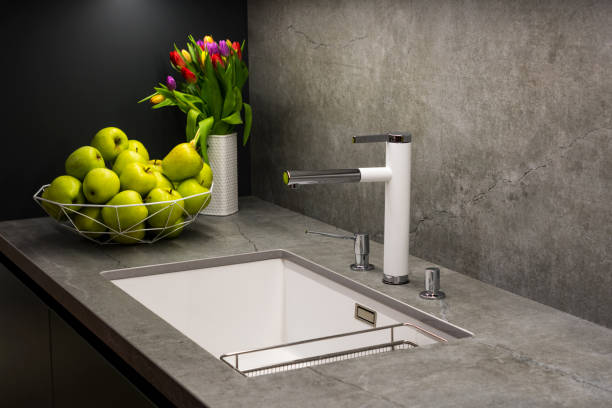
- Laminate
An affordable and versatile option, laminate countertops come in a wide range of colors, patterns, and textures, suiting various kitchen styles. These are non-porous and won’t absorb bacteria. They never require resealing, but can be easily damaged by heat. A great way to stay on budget, but laminate countertops don’t add to your home value.
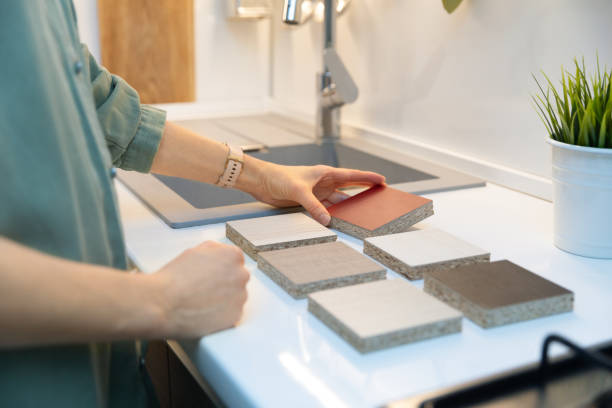
Aesthetics and Trends
- Dramatic veining: Natural stone with stylish patterns remains popular.
- Integrated designs: Countertops and backsplashes made from the same design for a seamless look.
- Textured and honed surfaces: Moving away from purely polished surfaces to add depth and texture to your kitchen.
- Waterfall edges: A trend where the material extends vertically down the side of an island or cabinet.
Conclusion
From bold, high-contrast natural stones with dramatic veining like quartz, granite, and marble to butcher block, stainless steel, concrete, and laminates, kitchen countertops offer diverse styles and benefits like durability, heat and stain resistance, and easy maintenance. Design ideas range from incorporating concrete for industrial vibes to choosing stone-effect surfaces for depth and texture for a polished, modern look.
FAQs
What’s the disadvantage of marble countertops?
Marble, known for its timeless elegance, is softer than other natural stones. Any direct cut can scratch the surface. Also, it’s porous, so any spills ned to be cleaned up fast to prevent permanent staining.
Where are stainless steel countertops used?
Stainless steel countertops are commonly used in commercial kitchens as they are resistant to rust and corrosion, and their non-porous construction makes it easy to keep the area clean.
Which is better, a 2cm or a 3cm countertop?
If you have a tight budget or you plan on DIY installation, a 2cm thick countertop is the right choice, whereas a 3cm countertop is a better choice if you prioritize longevity and sturdiness.
Are concrete countertops a good choice?
Concrete countertops provide a stylish, industrial look and are customizable, but they need regular sealing and can stain or scratch over time.
What kitchen countertop is best for baking?
Marble countertops stay naturally cool, making them ideal for rolling dough and baking activities, though they require more care to avoid stains and scratches.




